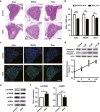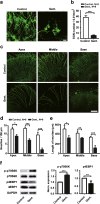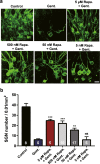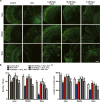Rapamycin Protects Spiral Ganglion Neurons from Gentamicin-Induced Degeneration In Vitro
- PMID: 31236744
- PMCID: PMC6797692
- DOI: 10.1007/s10162-019-00717-3
Rapamycin Protects Spiral Ganglion Neurons from Gentamicin-Induced Degeneration In Vitro
Abstract
Gentamicin, one of the most widely used aminoglycoside antibiotics, is known to have toxic effects on the inner ear. Taken up by cochlear hair cells and spiral ganglion neurons (SGNs), gentamicin induces the accumulation of reactive oxygen species (ROS) and initiates apoptosis or programmed cell death, resulting in a permanent and irreversible hearing loss. Since the survival of SGNs is specially required for cochlear implant, new procedures that prevent SGN cell loss are crucial to the success of cochlear implantation. ROS modulates the activity of the mammalian target of rapamycin (mTOR) signaling pathway, which mediates apoptosis or autophagy in cells of different organs. However, whether mTOR signaling plays an essential role in the inner ear and whether it is involved in the ototoxic side effects of gentamicin remain unclear. In the present study, we found that gentamicin induced apoptosis and cell loss of SGNs in vivo and significantly decreased the density of SGN and outgrowth of neurites in cultured SGN explants. The phosphorylation levels of ribosomal S6 kinase and elongation factor 4E binding protein 1, two critical kinases in the mTOR complex 1 (mTORC1) signaling pathway, were modulated by gentamicin application in the cochlea. Meanwhile, rapamycin, a specific inhibitor of mTORC1, was co-applied with gentamicin to verify the role of mTOR signaling. We observed that the density of SGN and outgrowth of neurites were significantly increased by rapamycin treatment. Our finding suggests that mTORC1 is hyperactivated in the gentamicin-induced degeneration of SGNs, and rapamycin promoted SGN survival and outgrowth of neurites.
Keywords: gentamicin; inner ear; mammalian target of rapamycin; ototoxicity; spiral ganglion neurons.
Conflict of interest statement
The authors declare that they have no conflicts of interest.
Figures






Similar articles
-
PRDX1 activates autophagy via the PTEN-AKT signaling pathway to protect against cisplatin-induced spiral ganglion neuron damage.Autophagy. 2021 Dec;17(12):4159-4181. doi: 10.1080/15548627.2021.1905466. Epub 2021 Apr 12. Autophagy. 2021. PMID: 33749526 Free PMC article.
-
Restoring autophagic flux attenuates cochlear spiral ganglion neuron degeneration by promoting TFEB nuclear translocation via inhibiting MTOR.Autophagy. 2019 Jun;15(6):998-1016. doi: 10.1080/15548627.2019.1569926. Epub 2019 Feb 1. Autophagy. 2019. PMID: 30706760 Free PMC article.
-
Inhibition of mTOR by Rapamycin Results in Auditory Hair Cell Damage and Decreased Spiral Ganglion Neuron Outgrowth and Neurite Formation In Vitro.Biomed Res Int. 2015;2015:925890. doi: 10.1155/2015/925890. Epub 2015 Mar 31. Biomed Res Int. 2015. PMID: 25918725 Free PMC article.
-
Age-related loss of spiral ganglion neurons.Hear Res. 2010 Jun 1;264(1-2):93-7. doi: 10.1016/j.heares.2009.10.009. Epub 2009 Oct 23. Hear Res. 2010. PMID: 19854255 Free PMC article. Review.
-
Mechanism and Prevention of Spiral Ganglion Neuron Degeneration in the Cochlea.Front Cell Neurosci. 2022 Jan 5;15:814891. doi: 10.3389/fncel.2021.814891. eCollection 2021. Front Cell Neurosci. 2022. PMID: 35069120 Free PMC article. Review.
Cited by
-
Low-dose rapamycin-induced autophagy in cochlear outer sulcus cells.Laryngoscope Investig Otolaryngol. 2020 May 29;5(3):520-528. doi: 10.1002/lio2.392. eCollection 2020 Jun. Laryngoscope Investig Otolaryngol. 2020. PMID: 32596496 Free PMC article.
-
Insulin-like Growth Factor 1 Signaling in Mammalian Hearing.Genes (Basel). 2021 Sep 29;12(10):1553. doi: 10.3390/genes12101553. Genes (Basel). 2021. PMID: 34680948 Free PMC article. Review.
-
A Low Dose of Rapamycin Promotes Hair Cell Differentiation by Enriching SOX2+ Progenitors in the Neonatal Mouse Inner Ear Organoids.J Assoc Res Otolaryngol. 2024 Apr;25(2):149-165. doi: 10.1007/s10162-024-00938-1. Epub 2024 Mar 12. J Assoc Res Otolaryngol. 2024. PMID: 38472516 Free PMC article.
-
PRDX1 activates autophagy via the PTEN-AKT signaling pathway to protect against cisplatin-induced spiral ganglion neuron damage.Autophagy. 2021 Dec;17(12):4159-4181. doi: 10.1080/15548627.2021.1905466. Epub 2021 Apr 12. Autophagy. 2021. PMID: 33749526 Free PMC article.
-
mTOR Signaling in the Inner Ear as Potential Target to Treat Hearing Loss.Int J Mol Sci. 2021 Jun 14;22(12):6368. doi: 10.3390/ijms22126368. Int J Mol Sci. 2021. PMID: 34198685 Free PMC article. Review.
References
-
- Al-Ali H, Ding Y, Slepak T, Wu W, Sun Y, Martinez Y, Xu XM, Lemmon VP, Bixby JL. The mTOR substrate S6 kinase 1 (S6K1) is a negative regulator of axon regeneration and a potential drug target for central nervous system injury. J Neurosci. 2017;37:7079–7095. doi: 10.1523/JNEUROSCI.0931-17.2017. - DOI - PMC - PubMed
Publication types
MeSH terms
Substances
LinkOut - more resources
Full Text Sources
Research Materials
Miscellaneous

